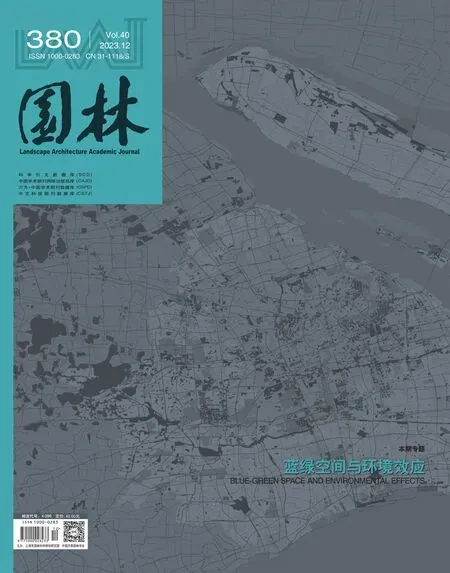蓝绿空间融合的城市生态系统服务
城市蓝绿空间是由城市区域内绿色空间和水体空间交织组成的整体,将其作为自然或半自然空间带入城市环境中,是实现人民高品质生活、推进城市高质量发展的重要资源。不同城市蓝绿空间资源不仅源于其所在地区的地理、地貌、气候、土壤等自然生态本底条件,更是城市长期以来经济结构、社会结构、文化传承发展背景下的物质空间载体。近年来,在各地的各层次空间规划编制与建设中,探索实施了具有地方性特征的蓝绿空间融合案例,出现了多尺度、多维度提升蓝绿空间系统服务价值,积极回应了经济、社会、环境等各方面城市空间诉求。
人类对于蓝绿空间环境效应的认知历程已逾百年。19世纪末,英国城市学家与社会活动家霍华德在其“田园城市”理论中,认为城市空间与耕地、牧场、森林、河流的镶嵌模式可以有效解决城市的社会问题与环境污染问题。20世纪以来,以麦克哈格、西蒙兹等为代表的景观与生态学家更加重视水域、绿色空间的多重价值,并将相关实践与理论研究结合起来。直到20世纪末,“生态系统服务”概念的提出,为蓝绿色空间环境效应的研究提供了新的理论基础与方法路径,蓝色、绿色空间的价值取向得到进一步明确。
本期专题“蓝绿空间与环境效应”,目的就是探讨如何通过城市蓝绿空间融合,科学构建城市生态系统,从而提高其生态服务价值供给。专题组织了8篇研究性论文,分别是结合理论研究与本土实践,在研究尺度上涵盖从宏观区域到微观场地,在环境效应上聚焦空间活力、气候调节、生物多样性、生态审美、低碳建设等学科核心与前沿问题等。单篇论文来看,或采用LBS大数据、田野调查、统计分析等手段,展示了蓝绿空间活力时空分布特征,揭示了影响活力的城市蓝绿空间耦合特征关键指标;或剖析城郊绿地冷岛效应的降温幅度和降温距离,并从空间格局特征和外部环境特征揭示了冷岛效应的影响因素;或研讨城市微绿地生物多样性的价值、影响因素与提升途径,为微绿地生物多样性提升提供科学的生境营造与布局规划策略;或针对城市湿地公园中湿地生态特征与游客审美体验间的冲突问题,以生态—审美协同为目标,从冲突表征、协同机制及实践对策三个层面探讨城市湿地公园自然教育途径。此外,积极推进产学研融合创新,立足具体项目,结合重庆市永川科技生态城蓝绿空间规划、四川仪陇县嘉陵江滨水空间更新、上海浦东环空铁枢纽生态战略规划等实践案例,探讨低碳新城蓝绿空间系统规划途径,考虑全生命周期的城市滨水空间低碳更新设计方法,以及生物多样性保护导向下的环空铁枢纽滨海蓝绿空间生态响应战略。
研究城市蓝绿空间融合,摸清其空间保护与营建方法途径,探索其城市生态系统服务理论与实用技术,是出发点也是目标点。过往学者们从“分离”的视角下,分别针对蓝色、绿色空间的各类环境效应已产出了丰硕的研究成果。当前,蓝绿空间作为融合的生态系统,其产生的环境效应,特别是系统服务价值供给,正受到更多关注。未来,期待更多学科、更多视角和更多学术同仁就此领域展开更深入的探讨。
2023年11月13日
Urban Ecosystem Services for the Integration of Blue-Green Spaces
Urban blue-green space,as a whole composed of interwoven green space and water space,Bringing it into the urban environment as a natural or semi-natural space is an important lever in realizing a high quality of life for the people and promoting the high-quality development of cities.The unique blue-green spatial resources of different cities not only originate from the natural ecological background conditions such as geography,landform,climate and soil of the regions where they are located,but also are the material space carriers in the context of the long-term development of the economic structure,social structure and cultural heritage of cities.In recent years,in the preparation and construction of spatial planning at various levels in various places,cases of blue-green space integration with local characteristics have been explored and implemented,and multi-scale and multi-dimensional enhancement of the service value of the blue-green space system has appeared,actively responding to the spatial aspirations of cities in various aspects,such as the economy,society and the environment.
It has been more than a hundred years since human beings recognized the environmental effect of blue-green space.In the late 19th century,British urbanist and social activist Howard,in his theory of “idyllic city”,believed that the mosaic pattern of urban space with cultivated land,pasture,forests,and rivers could effectively solve the social problems and environmental pollution in cities.Since the 20th century,landscape and ecological scientists such as McHarg and Symonds have paid more attention to the multiple values of water and green space,and combined the relevant practical and theoretical research.Until the end of the 20th century,with the introduction of the concept of “ecosystem services”,which provides a new theoretical basis and methodological path for the study of the environmental effects of blue and green space,the value orientation of blue-green space has been further clarified.
The topic of this issue,“Blue-Green Space and Environmental Effects”,is to explore how to scientifically construct urban ecosystems through the integration of urban blue-green space,so as to improve the ecological service supply.Therefore,8 research papers are organized,which combine theoretical research and local practice,cover from macro-region to micro-site in terms of research scale,and focus on biodiversity,climate regulation,ecological aesthetics,spatial vitality,low-carbon construction and other disciplinary core and cutting-edge issues in terms of environmental effects.By using LBS big data,field surveys,statistical analysis,and other means,the spatiotemporal distribution characteristics of blue-green spatial vitality were displayed,revealing key indicators of urban blue-green spatial coupling characteristics that affect vitality; The cooling amplitude and distance of the cold island effect in suburban green areas were analyzed,and the influencing factors of the cold island effect from the characteristics of spatial pattern and external environment were revealed; The value,influencing factors and ways to enhance the biodiversity of urban micro-greenland were discussed,and scientific habitat creation and layout planning strategies were provided for the enhancement of biodiversity in micro-greenland; The conflict between ecological features of wetland and tourists’ aesthetic experience in urban wetland parks was discussed with the goal of ecological-aesthetic synergy,and the three dimensions of the conflict characterization,the synergy mechanism and the practice were discussed; In addition,based on specific practice projects,the integration of industry,academia and research innovation are actively promoted.This topic combined the blue-green space planning of Yongchuan Science and Technology Eco-city in Chongqing Municipality,the renewal of the Jialing River waterfront space in Yilong County of Sichuan Province,and the eco-strategic planning of the Pudong Ring Air-railway Hub of Shanghai,to explore the systematic planning paths of bluegreen space for low carbon new towns,the design method of low-carbon renewal of urban waterfront space considering the whole life cycle,and the ecological response strategy of coastal blue-green space in the air-rail hub under the guidance of biodiversity conservation.
It is the starting point and target point to study the integration of urban blue and green space,find out the ways of space protection and construction,and explore the theory and practical technology of urban ecosystem services.In the past,scholars have produced fruitful research results on the environmental effects of blue and green spaces from the perspective of “separation”.Currently,as an integrated ecosystem,the environmental effects of blue-green spaces,especially the supply of system service value,are receiving more attention.In the future,it is expected that more disciplines,more perspectives and more academic colleagues will carry out more indepth discussions in this field.
November 13th,2023

